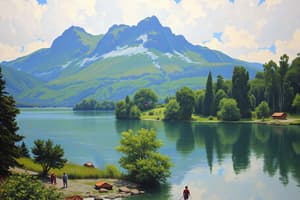Podcast
Questions and Answers
What is a fundamental aspect of physical geography?
What is a fundamental aspect of physical geography?
Which of the following is a form of renewable energy?
Which of the following is a form of renewable energy?
Why are many countries turning towards renewable energies?
Why are many countries turning towards renewable energies?
What is a common way to generate electricity from renewable sources?
What is a common way to generate electricity from renewable sources?
Signup and view all the answers
Why is finding alternatives to non-renewable energy sources important?
Why is finding alternatives to non-renewable energy sources important?
Signup and view all the answers
What is central to physical geography in relation to energy resources?
What is central to physical geography in relation to energy resources?
Signup and view all the answers
Study Notes
Physical Geography and Energy Resources
Physical geography focuses on the study of Earth's natural systems and interactions among its components. One crucial aspect of physical geography is energy, including both renewable and non-renewable forms. Understanding the distribution, usage, and potential of energy resources is fundamental for sustainable development and managing global consumption effectively.
Renewable Energy
Renewable energy comes from sources that naturally replenish themselves, such as sunlight, wind, water, and biomass. Many countries around the world are turning towards renewable energies to reduce carbon emissions and mitigate climate change. Solar panels, wind turbines, hydroelectric dams, and biofuels are common ways to generate electricity from renewable sources.
Non-Renewable Energy
Non-renewable energy, while abundant today, will eventually deplete. These resources include fossil fuels like coal, oil, and natural gas. While they currently supply most of the world's energy needs, their finite nature necessitates finding alternatives before they run out completely. There is ongoing research to convert old energy infrastructure to accommodate newer renewable technologies.
In conclusion, understanding the distribution, availability, and sustainability of energy resources is central to physical geography. Research and implementation of renewable energies are necessary to ensure future generations have access to cleaner and more efficient energy supplies.
Studying That Suits You
Use AI to generate personalized quizzes and flashcards to suit your learning preferences.
Description
Explore the relationship between physical geography and energy resources, including renewable and non-renewable forms. Learn about the distribution, usage, and importance of various energy sources in sustainable development and global consumption.




